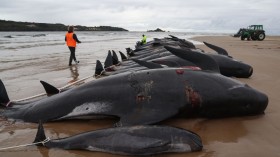Scientists from the European Space Agency (ESA) have proved that an old-fashioned technique can be an effective solution to 21st century problems, even if that solution dates back to the days of cavemen.
ESA's Solar Orbiter spacecraft, which will launch in 2017 to perform high-resolution imaging of the Sun, will be coated with a pigment once daubed onto prehistoric cave paintings: burnt bone charcoal.
The burnt bone charcoal will be applied to the Solar Orbiter's titanium heatshield, the ESA reports.
As its name implies, the Solar Orbiter mission will study the Sun at close range. The spacecraft will get as close as 42 million kilometers to the Sun, which is about a quarter of the distance from the star to Earth. At such a close distance, the spacecraft needs protection from Sun's powerful rays.
"The main body of the spacecraft takes cover behind a multi-layered 3.1 m by 2.4 m heatshield," Pierre Olivier, Solar Orbiter's safety engineer said in a statement. "And Solar Orbiter's instruments will operate at the far end of 'feed-through' lines that run through the shield, some under protective covers of beryllium or glass."
The use of burnt bone charcoal came about after preliminary testing identified flaws with the heatshield and the use of carbon fiber fabric was ruled out.
"To go on absorbing sunlight, then convert it into infrared to radiate back out to space, its surface material needs to maintain constant 'thermo-optical properties' - keep the same color despite years of exposure to extreme ultraviolet radiation," said Andrew Norman, an ESA materials technology specialist.
"At the same time, the shield cannot shed material or outgas vapour, because of the risk of contaminating Solar Orbiter's highly sensitive instruments. And it has to avoid any build-up of static charge in the solar wind because that might threaten a disruptive or even destructive discharge," he said.
The prehistoric pigment was given a modern upgrade by the Irish company Enbio and their CoBlast technique. The company's "Solar Black" compound - black calcium phosphate processed from burnt bone charcoal - will be applied to Solar Orbiter's outermost titanium heatshield.
The burnt bone charcoal at the heart of the Solar Black coating can enhance the absorption and reflective properties of metals such as titanium, aluminum and stainless steel, which possess a surface oxide layer.
"We spray the metal surface with abrasive material to grit-blast this layer off, but - as the CoBlast name suggests - we also include a second 'dopant' material possessing whatever characteristics are needed. This simultaneously takes the place of the oxide layer being stripped out," said John O'Donoghue, Managing Director of Enbio.
"The big advantage is that the new layer ends up bonded, rather than only painted or stuck on. It effectively becomes part of the metal - when you handle metal you never worry about its surface coming off in your hands."
© 2024 NatureWorldNews.com All rights reserved. Do not reproduce without permission.





